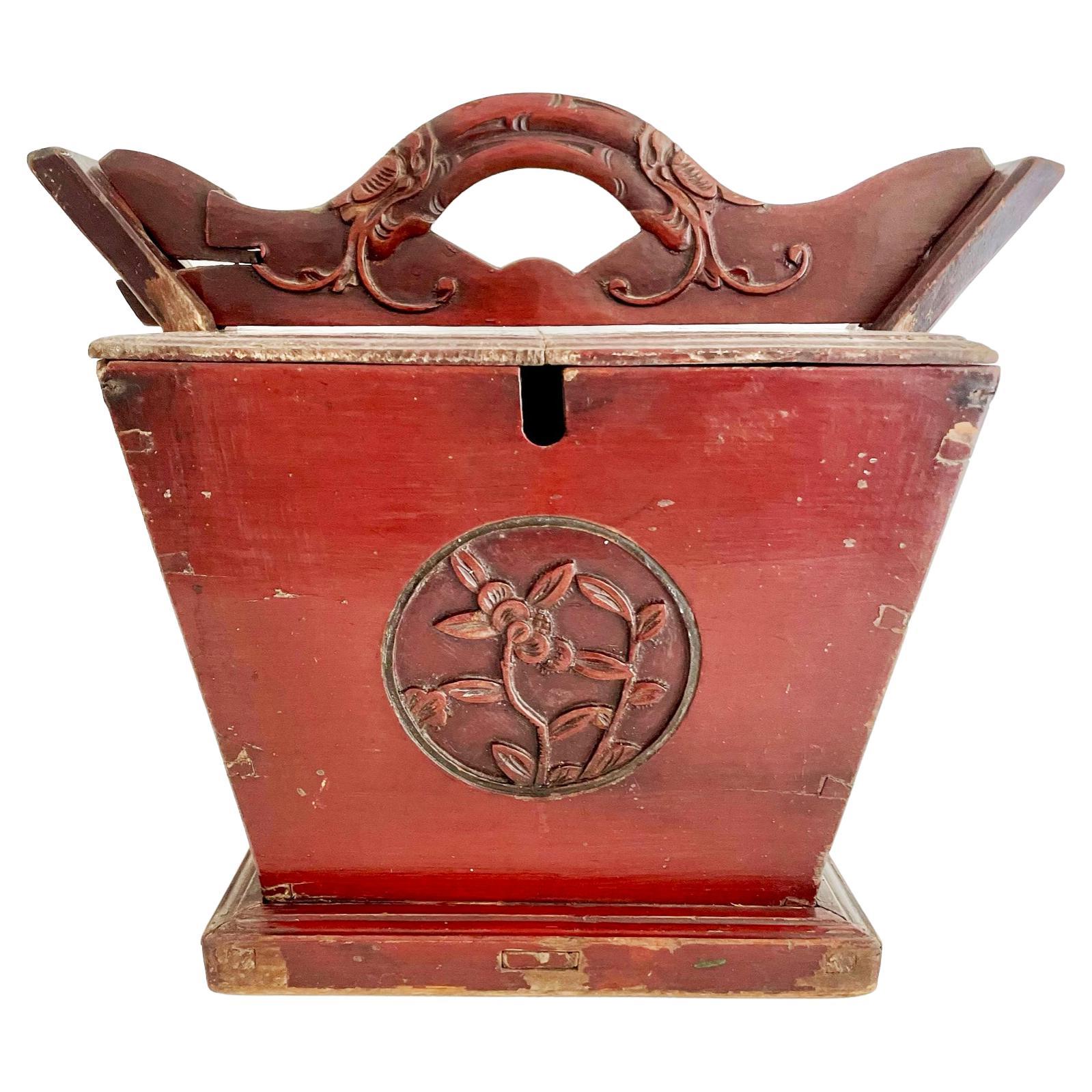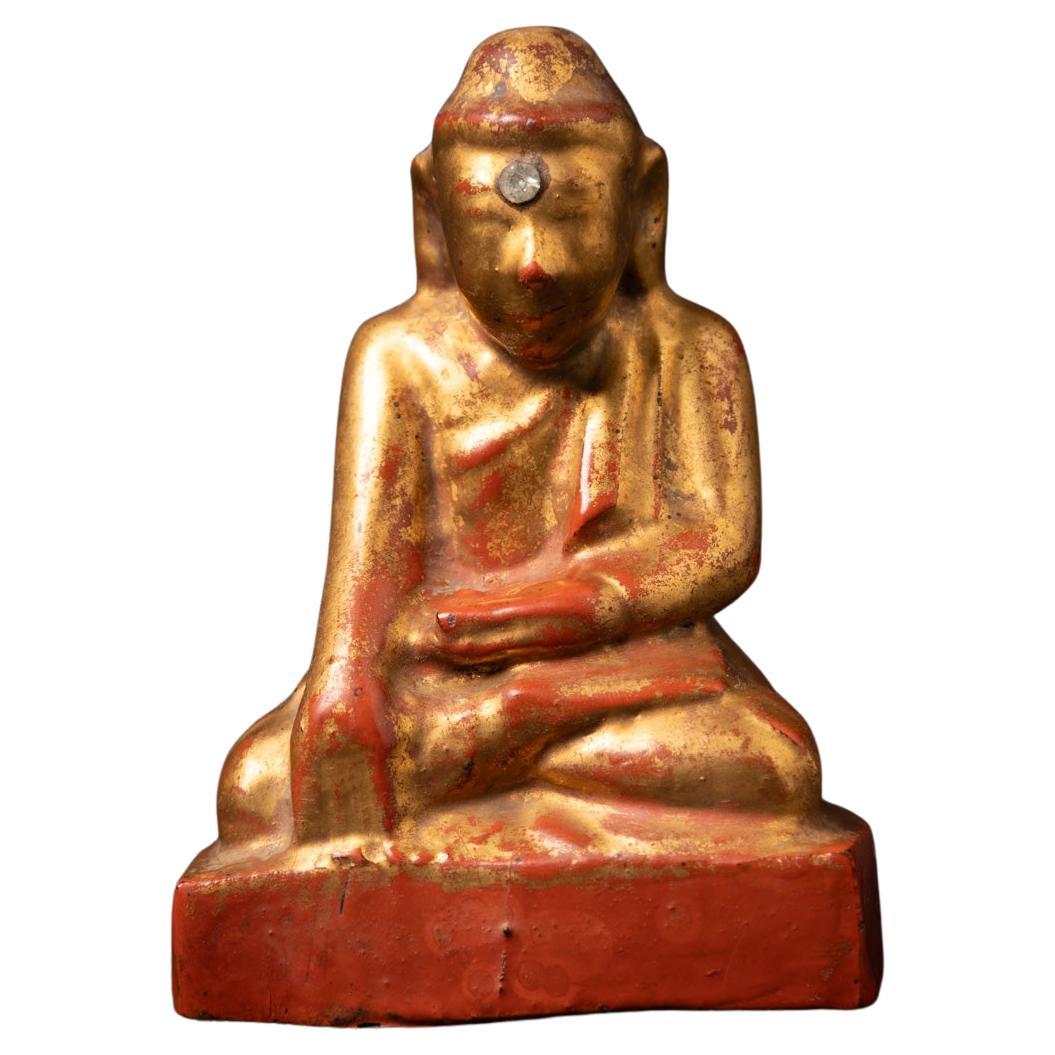Items Similar to Large Early 19th Century Gilded Carved Wooden Vietnamese Buddha
Want more images or videos?
Request additional images or videos from the seller
1 of 21
Large Early 19th Century Gilded Carved Wooden Vietnamese Buddha
About the Item
A highly decorative early 19th century Vietnamese carved wooden and polychrome painted Buddha with traces of original gilding, creating a beautiful patina. This Buddha has a beautiful, peaceful, benevolent face, seated in a meditation pose with dhyana mudra and asana.
Beautifully carved and lacquered with original traces of original gilding, this Buddha is seated on a stylized lotus blossom. There are light crackings on the face from shrinkage through the ages and minor cracks of the lacquer on the back of the lotus base. Minor repairs for strengthen the base was done during the lifetime of this Buddha.
- Dimensions:Height: 35.5 in (90.17 cm)Width: 29 in (73.66 cm)Depth: 23 in (58.42 cm)
- Materials and Techniques:
- Place of Origin:
- Period:
- Date of Manufacture:circa 1820
- Condition:Wear consistent with age and use.
- Seller Location:Atlanta, GA
- Reference Number:1stDibs: LU945033486882
About the Seller
5.0
Platinum Seller
These expertly vetted sellers are 1stDibs' most experienced sellers and are rated highest by our customers.
Established in 2006
1stDibs seller since 2010
479 sales on 1stDibs
Typical response time: <1 hour
- ShippingRetrieving quote...Ships From: Miami, FL
- Return PolicyA return for this item may be initiated within 2 days of delivery.
More From This SellerView All
- Large 19th century Chinese Carved Wooden Tea CaddyLocated in Atlanta, GABeautifully carved Qing dynasty tea caddy from Elmwood (yumu), with floral motifs and finished with an oxblood color lacquer. The large size is very usual and was used in a large family compound. The tea caddy is designed to hold and keep warm, large tea pot filled with tea. The tea pot’s spout comes out the front opening for pouring. The horizontal bar used as the container’s handle has a pivoting lock when open, the handle bar can be removed and closing of the pivoting lock, the handle is secure for use. The wooden tea caddy...Category
Antique Late 19th Century Chinese Sculptures and Carvings
MaterialsElm
- 19th Century Chinese Carved Wooden Altar GodLocated in Atlanta, GAThis Ching Dynasty carved polychrome seated Taoist altar god was once used on the family altar to honor their ancestors. Ancestor worship plays a major role in Chinese religion. This...Category
Antique Early 19th Century Sculptures and Carvings
MaterialsWood, Paint
- Large 19th Century Chinese Carved Tea CaddyLocated in Atlanta, GABeautifully carved Qing dynasty tea caddy from Elmwood (yumu), with floral motifs. Beautiful original patina, the body is in a brown lacquer and the handle is finished with an red color lacquer. The large size is very usual and was used in a large family compound. The tea caddy is designed to hold and keep warm, large tea pot filled with tea. The tea pot’s spout comes out the front opening for pouring. The horizontal bar used as the container’s handle has a pivoting lock when open, the handle bar can be removed and closing of the pivoting lock, the handle is secure for use. The wooden tea caddy...Category
Antique Late 19th Century Chinese Sculptures and Carvings
MaterialsElm
- Large 19th Century Chinese Carved Tea CaddyLocated in Atlanta, GABeautifully carved Qing dynasty tea caddy from Elmwood (yumu), with floral motifs and finished with an oxblood color lacquer. The handle has a finely carved bat motif, which symbolizes good fortune. The large size is very usual and was used in a large family compound. The tea caddy is designed to hold and keep warm, large tea pot filled with tea. The tea pot’s spout comes out the front opening for pouring. The horizontal bar used as the container’s handle has a pivoting lock when open, the handle bar can be removed and closing of the pivoting lock, the handle is secure for use. The wooden tea caddy...Category
Antique Late 19th Century Chinese Sculptures and Carvings
MaterialsElm
- 19th Century Painted Wooden Tibetan BowlLocated in Atlanta, GAA beautiful late 19th century paint bowl with a lid that was once used for storing the famous Tibetan barley flour (Tsampa). These bowls were used by the Buddhist mountain people of ...Category
Antique Late 19th Century Tibetan Sculptures and Carvings
MaterialsWood, Lacquer, Paint
- 19th Century, Gilded Lacquer Tsampa Bowl from TibetLocated in Atlanta, GAA beautiful late 19th century lacquer covered bowl that was once used for storing the famous Tibetan barley flour (Tsampa). This beautifully handcrafted wooden bowl has a gorgeous, l...Category
Antique Late 19th Century Tibetan Sculptures and Carvings
MaterialsWood, Lacquer, Paint
You May Also Like
- 19th Century Gold Gilded Bronze BuddhaLocated in Vero Beach, FL19th century gold gilded bronze Buddha A finely cast bronze Buddha statue in gold gilt with modeled and incised floral motifs. This jeweled God o...Category
Antique 19th Century Chinese Qing Sculptures and Carvings
MaterialsBronze
- 19th Century, Wooden Mandalay Buddha from BurmaLocated in DEVENTER, NLMaterial: wood 77 cm high 63 cm wide and 41 cm deep Weight: 30.25 kgs Gilded with 24 krt. gold Mandalay style Bhumisparsha mudra Originating from Burma 19th century With in...Category
Antique 19th Century Burmese Sculptures and Carvings
MaterialsWood
- 19th century Antique wooden Burmese Buddha statue from BurmaLocated in DEVENTER, NLMaterial : wood 10,6 cm high 7,8 cm wide and 6 cm deep Gilded with 24 krt. gold Mandalay style Bhumisparsha mudra 19th century Weight: 117 grams Originating from Burma Nr: 2530-11Category
Antique 19th Century Burmese Sculptures and Carvings
MaterialsWood
- Large Burmese Bronze Medicine Buddha, Pagan Style, Late 19th CenturyLocated in Austin, TXA large and magnificent cast bronze image of the Medicine Buddha, Bhaisajyaguru, rendered in the Burmese Pagan style, and most likely based on a period example that was either damaged or lost, 19th century, Burma or Thailand. He can be identified as the Medicine Buddha by the hand that rests in his lap, with his middle finger touching the thumb. A medicine pot or fruit stem would originally have been placed in his upturned palm. The face of this Buddha has been sculpted masterfully. He has a beautiful heart shaped face topped by hair neatly arranged in the typical "snail shell curls", and surmounted by a high ushnisha. Long, pendulous earlobes frame his face, a symbol of his princely past. He gazes serenely outwards from heavily lidded, downcast eyes, a content smile upon his full, lush lips. The Buddha is portrayed seated in vajrasana (full lotus position), his elegant hands displayed in varada mudra, the gesture of granting favors and fulfilling wishes. Long, exquisite fingers extended, the thumb and middle finger touching in a gesture of compassion. He is clothed in a simple kasaya wrapped around his body and over one shoulder, leaving the shoulder and part of his chest bare. The diaphanous garment clings to his body, outlining his well proportioned and graceful, almost sensuous, form. The excess material pooled in neat pleats in front of him. A sash thrown over his shoulder. He sits upon a double lotus base upon a raised platform. The platform features two kneeling attendants, usually interpreted as the monks Ananda and Kasyapa. Between them is a circular disc representing the Wheel of Dharma. Contained in the disk is a flower with eight petals, symbolizing the eightfold path, one of the principle teachings of the Buddha. The sides and back of the platform featuring a series of singha, or lions, representative of the Buddha's royal past. An applied lacquer patina covers the entirety of the image. Large deposits of ash (from incense) are present between the curls of the hair, as well as some the other crevices, indicating this image was the subject of worship for many years. Bhaisajyaguru, also called the Medicine Buddha, or Buddha of Healing, is a revered figure in the Buddhist pantheon as a master able to cure suffering, both physical and spiritual, through his teachings. The Pagan Empire ruled most of present day Burma (Myanmar) from 849 to 1297. The capital, Bagan, served as a both the center of government and religion, where Buddhism reigned supreme. Bagan was also at a crossroads of the Buddhist world, with influence from India, Nepal, Tibet, China, and even Indonesia shaping their culture. As such, Pagan Buddha...Category
Antique Late 19th Century Burmese Sculptures and Carvings
MaterialsBronze
- Early 19th century Antique bronze Thai Chiang Saen Buddha from ThailandLocated in DEVENTER, NLAntique bronze Thai Chiang Saen Buddha Material : bronze 64,5 cm high 53,5 cm wide and 36 cm deep With traces of 24 krt. gilding Bhumisparsha mudra Early 19th century Weight: 27,8 kg...Category
Antique Early 19th Century Thai Sculptures and Carvings
MaterialsBronze
- Early 19th century Special antique bronze Burmese Buddha statue from BurmaLocated in DEVENTER, NLThis Early 19th century Special antique bronze Burmese Buddha statue is a truly unique and special collectible piece. Standing at 39.5 cm high, 27.3 cm wide, and 20.3 cm deep, it is...Category
Antique Early 19th Century Burmese Sculptures and Carvings
MaterialsBronze
Recently Viewed
View AllMore Ways To Browse
Antique Gilding
Trace Antique
Large Wooden Base
Early 19th Wooden
Highly Carved Wood
Large Wooden Sculpture
Wooden Face
19th Century Gilded Age
Large Carved Wooden Art
Polychrome Carving
Hand Carved Buddha Sculpture
Asian Wooden Decorative
Large Asian Wood Carving
Large Buddha Sculpture
Buddha Face
Carved Wood Buddha
Gilt Buddha
Gilted Buddha





